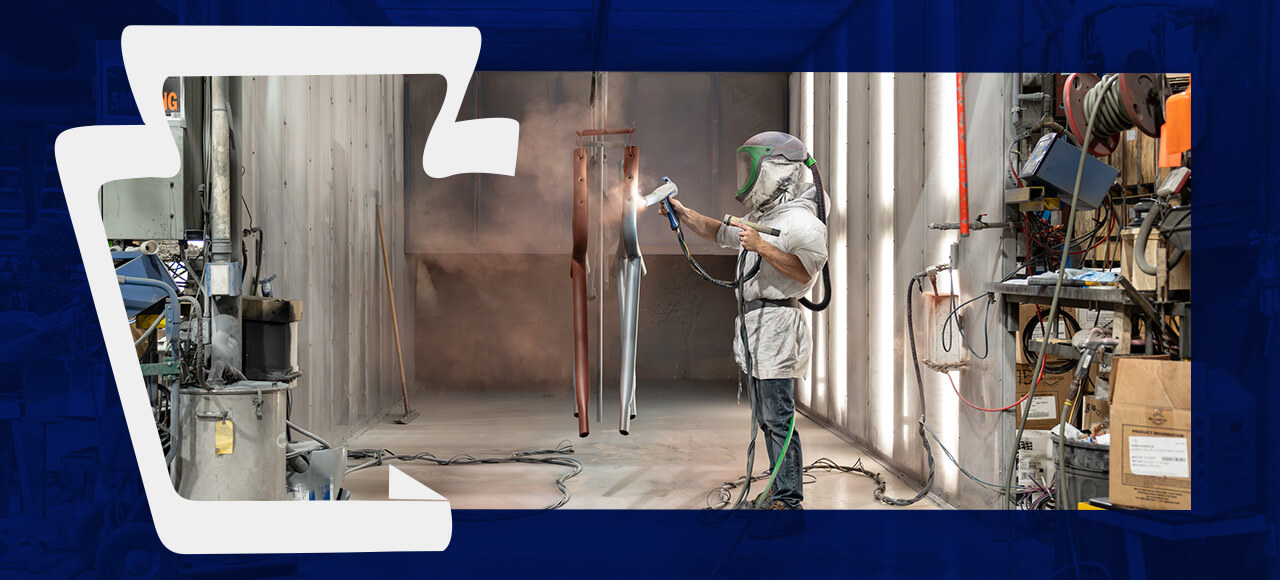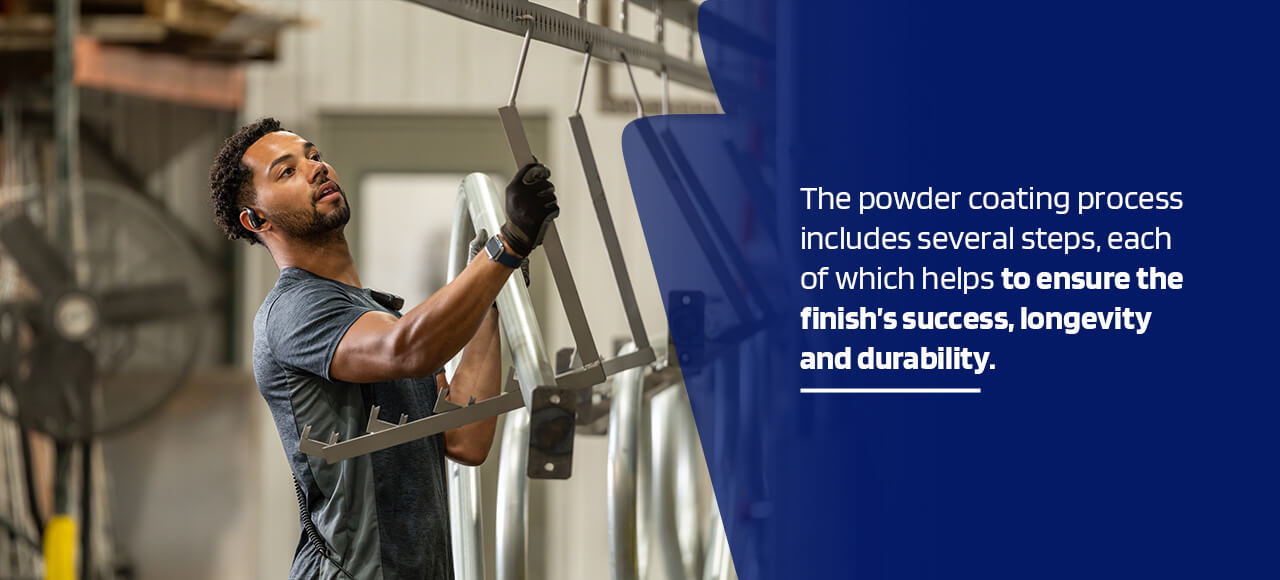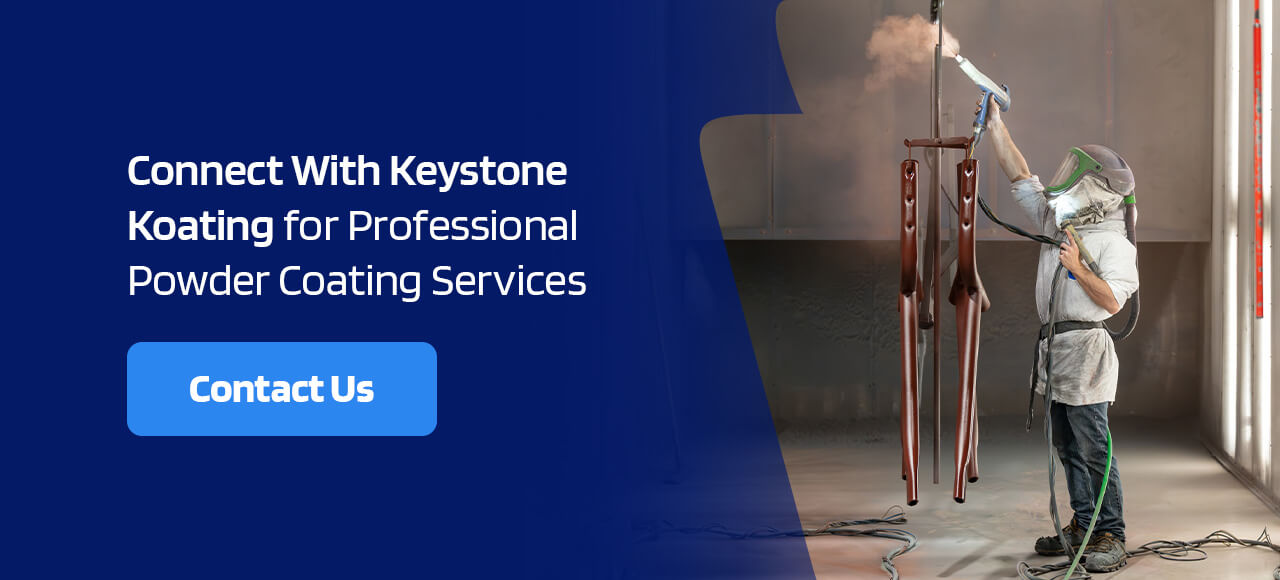
Powder coating provides a durable, lasting alternative to liquid paint. Its application process requires careful pretreatment and an electrostatic charge to adhere the pigmented coating onto the surface. With powder coating, surfaces have protection and visual enhancement, making this finish an ideal option for many industries.
Table of Contents
Powder Coating Definition
Powder coating is a dry powder applied to a charged surface, creating a thicker coating in one application more than a single coat of paint. An electrostatic charge holds the coating onto the surface, which remains in place after curing the object. Due to the intensive process required to prepare and coat the surface, powder coating is a practical approach for large-volume orders.
What Is Powder Coating Made Of?
Powder coatings consist of several ingredients. A polymer resin creates the finish’s core. Additional elements in the coating include ingredients to help with curing, pigments to add color, and flow modifiers. These parts work together to create a colored, protective surface that performs well in many environments after curing.
Types of Powder Coating
Generally, there are two types of powder coating – thermoplastic and thermoset. These differ in their curing methods and properties.
First, thermoplastic is a coating that melts and flows when heated, yet maintains the same chemical composition once it solidifies. It offers better resistance to impacts in the finished product. Plus, it does not need a curing cycle. Instead, the coating requires time and high temperatures to melt, flow evenly over the surface. Because it does not undergo curing, it can soften and remelt when subjected to high temperatures. Thermoplastic powder application requires a much thicker millage than thermoset powder coatings and often does not offer as nice of a visual appearance as compared to a thermoset.
Secondly, thermoset powder coatings go through an irreversible chemical change during curing to create a long-lasting, hardened coating. While thermoset coatings still melt and flow when heated, their structure chemically cross-links to form a different chemical composition than the base resin. Because the changes after curing are permanent, this type of coating will not remelt under intense temperatures. Plus, it provides better scratch resistance compared to thermoplastics. Thermoset powder coatings develop thinner films, which can be more visually appealing than some thermoplastic. However, when applied in thick layers, it can become brittle or crack.
Because these types of powder coatings have different properties, the best choice depends on the finished product’s application and use.
What Is Powder Coating Used For?
Powder coating has many applications in automotive, aerospace, manufacturing, and other industries that require durable finishes for products. Thermoplastic coatings can be beneficial in functional settings, such as dishwasher racks, playground furniture, light poles, and pipes. Meanwhile, thermoset powder coatings are useful in a wide array of applications, from lawn and garden products such as mowers or shovels to furniture, fencing, building facades, and many, many more.
How Does Powder Coating Work?
Powder coating uses an electrostatic process and curing to adhere the powder to the surface. Because the parts must undergo high temperatures to set the coating, the substrate must also be heat-resistant. However, most products coated with this finish are metal and easily hold up throughout the process.
How Powder Coating Sticks to Surfaces
Surfaces that use electrostatic applications have the metal components grounded. While the powder itself is inert, it gains an electrostatic charge as the particles pass through the spray guns. The guns have an electrode fitting that adds an electrical charge to the powder particles. When sprayed onto the grounded surface, the particles stick. They become solidified into a dense coating during the curing process that melts and sets the finish.
Another less frequently used method is a curing fluidized bed. This method heats the part first. Next, the heated part submerges into a bed of powder coating. The heat melts the coating, which covers the surface evenly. This method works for thermoplastic coatings and non-metal materials.
How Powder Coating Protects Surfaces From Corrosion
The durable powder coating provides a thick surface over the part. It resists damage from impacts and scratches. Unlike paint, powder coating generally does not require touch-ups due to chipping or fading. It provides long-lasting color for applications in harsh environments.

What Is the Powder Coating Process?
The powder coating process includes several steps, each of which helps ensure the finish’s success, longevity, and durability.
Blasting
Blasting is a step used to remove inorganic contaminants, like welding smut, rust, and laser scale, or for previously finished surfaces. The blasting process uses abrasives to take off paint or other finishes, rust, or corrosion. By ensuring the surface does not have contamination, the finishing company can ensure better powder coating adhesion.
Pretreatment
The most critical step of the powder coating process is pretreatment. This step is so crucial that we use an eight-step pretreatment method. First, an alkaline cleaner takes off organic liquid and dust contaminants. This stage finishes with two thorough rinses to remove all surface debris and cleaning chemical.
Next, the part undergoes an iron phosphate application to prepare the surface for better powder coating adhesion, and improved corrosion resistance. Dual rinses get all traces of the iron phosphate from the part’s surface.
A reverse-osmosis water rinse removes any remaining solutions from the surface. Finally, a chrome-free zirconium sealer covers the surface. This layer dries in place and seals the surface, readying it for the following stages of powder coating.
Primer
A primer added to the surface before the powder coating application is optional. However, it can help the finish on aluminum or steel products last up to four times longer than non-primed surfaces. Therefore, consider priming aluminum or steel components intended for outdoor use.
Masking
Masking blocks off areas of the part that do not need powder coating. It protects these areas from the coating process and ensures clean threads or machined areas.
Coating
The coating process has either an automatic system or a professional finisher, which spray the grounded metal parts with charged powder coating. The coating sticks to the surface through electrostatic bonds.
Curing
Curing melts the resins in the powder and turns it into a durable coating. The timing and temperature used for curing depend on the coating thickness, substrate material, item size, and other factors. Professionals use these aspects of the part to calculate the precise curing time. After curing, the part cools and moves on through packaging and shipping.
Connect With Keystone Koating for Professional Powder Coating Services
Reach out to Keystone Koating for commercial or industrial-grade powder coating services. Our eight-stage pretreatment process ensures quality adhesion of powder coating that lasts. Plus, we can provide quick turnarounds for large-volume orders. With our turnkey solutions, your business benefits from a complete coating process that starts with blasting and ends with packaging and shipping. We’ve been trusted for over 30 years on industrial or commercial projects such as yours. Contact us for a quote


